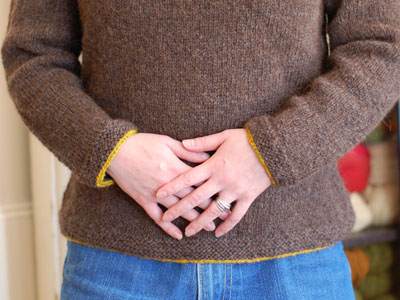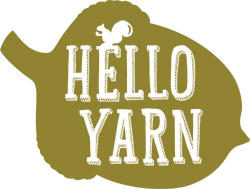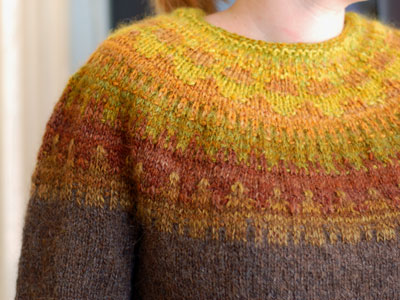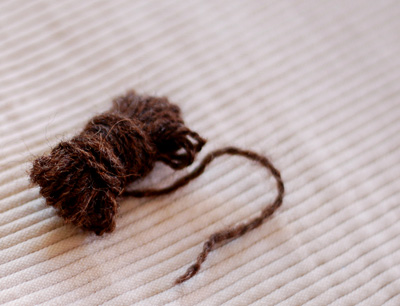Fantom Bohus: Q&A
First of all, thank you so much for your lovely comments. You make a girl feel fancy!

I forgot to give photo props to Mr. HelloYarn in the last post. He rocks the D50.
I asked for questions, and you gave me some great ones. Many of you asked things I’d been meaning to discuss. Thank you! Please keep in mind I’m no Bohus stickning expert, but I’ll do my best not to steer you wrong.
Pumpkinmama asked:
My question – there’s a lot of hype about the Bohus these days, and I guess I don’t get why its seen as such a challenge (apart from the tiny gauge on the traditional ones) – is it really just color work with purls in it or is there some other aspect that I’m totally missing?
It’s really just colorwork with purls in it. It reminds me a lot of Icelandic Lopi sweaters. If you can do that, you can do this. There are 3 or more colors per row in some designs, and the typical gauge was about 9 sts. per inch. The sweater patterns in Poems of Color by Wendy Keele are written at 7 sts. per inch. I believe the kits that are available now (scroll down for the link) are back in the 8.5-9 sts. per inch range. The gauge of the originals is the only thing I find daunting, at least if I was doing the spinning as well as the knitting. My sweater is a majorly simplified version or maybe it’s just more of a nod towards Bohus knitting.
Anj asked:
Is Bohus traditionally knit in worsted? or is it more a fingering weight and that was your re-interpretation?
According to Poems of Color, the yarn used for the first Bohus sweaters was sport or worsted-weight wool. After about 10 years, a finer 70/30 fine wool/angora was developed for the sweaters, and after that, an even softer yarn with 50-60% angora and 40-50% wool was developed. I can’t find an actual mention of the knitting weight of these later yarns, but the gauge is leading me to believe it’s on the fine side of fingering weight. Since I’m so allergic to angora that you may as well take me straight to a hospital if I touch it, my yarn had a halo courtesy of mohair and alpaca.
Kimley asked:
Are you going to wear it to Rhinebeck?
Yes, yes I am. :)
Regina asked:
I imagine there will be something between you and that glorious sweater, like a jersey or tee of some sort?
Yes, once it gets below 60F, you won’t find me without a long-sleeved t-shirt on. I’m sure I’d be fine wearing this over a short-sleeved shirt, as well, but some might not be.
Jess asked:
So, why did you decide on garter stitch cuffs and hem? From what I’ve seen of Bohus sweaters, that’s not a “traditional” choice, so I was curious why you decided on it (other than squishy squishy garter stitch love).
If you look back at the sweater a little while ago, you’ll see the neck was ribbed, which seems to be, from the photos I’ve seen, the traditional choice. I ribbed the bottom edging, as well, and just couldn’t make that contrast edge look as lovely as I imagined it. I ripped it back and did it in garter and ahhhh, it was beautiful. So, the neck went and was replaced by garter, as well. There was cutting. It didn’t start out as garter love, though that abounds, but it ended that way! There are some mittens in Poems of Color with garter cuffs. They’re gorgeous!
Beth S. asked:
I want to know about the contrast piping on the edges–is that slip-stitch crochet, or did you just cast on and knit one row before changing to the main color? Either way, it is a brilliant touch!
The sweater was knit from the top down, so those contrasting edge rows are the bind-off rows, which is why they look so super. This was my second time doing a contrasting edge on a sweater, and I’ve done one since, and this is definitely the most beautiful edge I’ve produced. The first was a hem and the second a cast-on edge. I dislike the latter enough that I may go back and take that edge out, then replace with a bind-off in the contrast yarn. I’m thinking that for bottom-up projects, the best way to go about this edge would be to cast on in the main color and come back and pick up and bind off in the contrast color. I haven’t found a cast-on that looks that nice. Does anyone know of one?
Mandy asked:
A question. Do you have a standard rate of decreasing and increasing for the waist shaping? Like, do you decrease at the side seam every 3rd row or every 4th row or something different? I’m trying waist shaping (not from a pattern, EZ style, for the first time) and every 3rd row seems like maybe it’s too quick. Thanks!
I do. I decrease 2 sts. at each side seam area (4 decreases per round) once every inch, then leave about 2 inches straight knitting in between the decreases and increases. I have a bit of a short waist, so your mileage may vary, at least on the distance between increases and decreases. Shaping more often than every inch makes a really steep slope- too steep for me.
Erica asked:
One question I have is related but more of a general one- if sometime you wanted to discuss spinning for a specific project, i.e. how you figured out just how much fiber you would need for your lovely sweater? I tend to use the trial and error method… which doesn’t much help when you are going to order some fiber and fear it is/isn’t enough.
Sample. If you can do that, you are golden. If you can’t for whatever reason, it helps to know your own spinning, for sure. Compare your handspun to a commercial yarn of the same fiber. Does your 200 yards of 2 ply worsted weight weigh the same as a commercial counterpart? Chances are, it weighs a bit more. If you are a newer spinner, chances are, it weighs a whole lot more, as I’ve noticed new spinners tend to put too much twist in their yarn, causing it to be denser than necessary. Knowing your spinning will help you purchase fiber on the fly, with no real project in mind, and where you can’t buy a bit of fiber to sample and go back and get what you need later. If you have a pattern in mind, or know that you generally need 1,000 yards of worsted weight for a typical sweater in your size, then you can guess that you will need 1.25 lbs. of wool to make that 1,000 yards, if you typically get 200 yards of worsted per 4 oz. Buy at least 1.5 lbs. and you should be good, since different breeds of wool and preps can will affect the weight of fiber used. Buy 2 lbs. to really be on the safe side and rejoice when you use 1.25 lbs. and have enough left over for something else!
Loopykd had 2 questions!
How long did this take?
I started knitting in June, but this was not the only thing I knit during that time. I spun the first skein back in November 2006, without any plan for this sweater. I had a plan and started spinning the other colors for this sweater in May of this year. I have no idea how many hours this took, as I don’t keep track. Ripping the yoke out twice certainly added some working time to this puppy!
Also, how do you address sleeves and armpits in the round?
I did something different for the armpits of this sweater. When I finished the yoke and needed to split the arms from the body, I cast the underarm stitches (8% of body sts. as directed by Elizabeth Zimmermann’s Percentage System) for the body on with the backwards loop cast-on and when I got to the sleeves, picked up and knit from that cast-on edge. It’s not as tidy as a perfect graft, but it’s much simpler and looks really nice. I’ll do it again.
Grace asked:
So what does this GORGEOUS sweater weigh? I’m guestimating 2 lbs?
It weighs 1 lb. 6 oz. There is a whole lot of the yoke yarn left. The dyed fiber I used comes in little cello bags weighing between 2 and 6 oz. I selected bags that weighed around 3 oz. each, figuring that with five different colors, there’d be plenty to play with, and there was.
I’d like to plug Fantom Farm here. If you go to Rhinebeck, look for the booth with the little candy-colored cello bags of fiber hanging all over the place. It’s like crack- or potato chips- or something. You can’t buy just one, and you shouldn’t.
Lizzie asked:
Does it have a little stripe of yellow going up the sleeve, or is that something in the photo?
There’s no stripe!
Links to other interesting Bohus stuff:
Shop for a kit.
Take a class.
Fluffbuff’s account of the class she took, including pronunciation help (I love you, fluffbuff, for teaching me how to say the word!)
Bohus group on Ravelry
Flickr image search


